Is there more than one authentic Citroën 15-Six convertible?
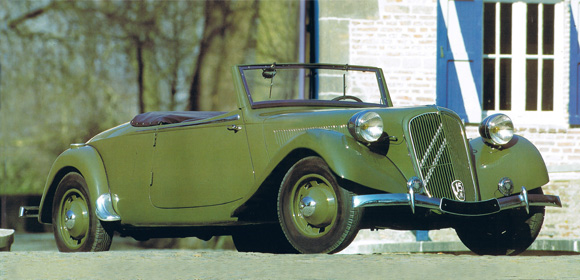
by Per Ahlstrom…
A Traction Avant 15–Six convertible was recently sold at the Osenat auction in Paris on March 15, 2015 and fetched €612440 ($841,599.00 CAD, $662,702.00 USD), which is a world record price for a Traction Avant. The question is: Did the buyer get what he thought he was buying?
It is still unclear how many 15-Six convertibles were produced. Three? Four? Five? Seven? Eight? Or maybe even nine? Considering the uncertainty around the 15-Six convertibles, caution is advised before paying big money for a car showing any gap at all in its documented history, especially a car that does not have a correct chassis number assigned by the factory and verified by the Citroën Conservatoire.
The car auctioned off in March was described by the auction company as one of three Citroën Traction Avant 15-Six Convertibles made in 1939. [See auction catalogue here: https://asp.zone-secure.net/v2/index.jsp?id=2637/4313/53776&lng=fr (page 80-83).]
No solid proof
The catalogue mentions that several 15-Six convertibles were made in the 1950s, by independent coach builders who converted 15-Six sedans to convertibles, but claims that this car is not one of them. The car is said to have a “carte gris” (title) from 1946, and to have been born with a D-engine. The D designates “droit” (for right), as these engines turn clockwise. The first version of the Citroën 15-Six engine turned left and thus later was designated “G” for “gauche”. If this convertible really was built in 1946, it would originally have had a G-engine installed, as the D-engines were introduced in October 1947, (beginning around chassis #682 730). The chassis numbers vary widely during one and the same production day, so to determine which car was the first to receive a D-engine you have to go to the engine numbers. G-engines were designated numbers beginning with PD or PE. D-engines have numbers starting with PJ in October 1947, and then go on with PK, PL, PM, PR, PQ and PS. Thus it should be easy to determine when the engine of this convertible was made.
Even if this actually is one of three surviving 15-Six convertibles from 1939, as the seller claimed, its drivetrain must have been exchanged for a later version at some point in its life. Unless this car was used as a test bed for a D-engine, which certainly would have been mentioned if it was a known fact, it is highly improbable that a D-engine could have been installed in a car leaving the Citroën factory in 1946. Cars normally got their production number when the engine was installed, thus a car with a 1939 (or 1946) number would have a G-engine installed.
History known from the 1960s
So what about the body? Does the chassis number match the claim that the car is a 15-Six convertible, that was not finished in 1939 and that the parts for the car were stored in the basement of the factory until the car could be finished in 1946? Nothing is said about its history throughout the 1950s. The auction company only says that the car came into the hands of a Citroën dealer in the 1960s, who used it for rallies and shows until he put it up for auction this spring. The auction company does not present a documented, unbroken provenance for the car. It does however mention that the provenance of the car is certified in a book by renowned Traction Avant specialist Olivier de Serres. In his book on the Traction 15-Six he traces the history of this car to the best of his ability.
According to de Serres, it is not easy to tell exactly when the car was built, but that it is likely that the body was assembled before the war. The windshield frame is stamped with the date May 18 1939, which is close to the date of manufacture, May 20 1939, for the one 15-Six convertible that has a fully known history; the car delivered to the widow of Pierre Michelin, the former CEO of Citroën, who was killed in a car accident 1937. More about that car later. But as the car sold at auction this March does not have a regular chassis number, it is, according to de Serres, likely that it was not finished before WWII, that it is one of the cars that were stored in the basement of the Citroën factory during the war, and that it was assembled in 1946, when Citroën car production was resumed.
One-off chassis number
Citroën chassis numbers are a science of their own, but the chassis number of this car, 184.60.75 does not seem to be a Traction Avant chassis number at all. Jens Møller Nicolaisen, a well known Danish TA historian, has spent a lot of time at the Citroën Conservatoire, plowing through the old ledgers to find out what cars really were produced when. And he has not come across any Citroën Traction Avant chassis number resembling the number of this car. This number definitely has not been assigned by the Citroën factory. The car also does not have a production number, which would have been assigned to the car at the time the body was assembled and married to the drive train.
The big question is of course why a car built at the Citroën factory would not have been assigned neither a chassis, nor a production number? In spite of this, de Serres seems to accept that the car is a genuine 15-Six convertible.
What can be ascertained, is that it was registered in 1946, when it was given a one-off VIN by the French Service de Mines. Olivier de Serres’ opinion is that the only uncertain period in the history of the car is between 1964 and 1966, between a Swiss owner, Raoul Wander, and the well known Citroën dealer and collector Denys Joannon. Wander claims to have bought the car from the Michelin family, but no proof supports the story.
de Serres claims that the car was modified in the 1950s, with a right-turning D-engine replacing the original G-engine, which of course also necessitated a new gearbox and a new grille with an elongated hole for the crank. (The gearboxes for the Six have three axles. The G-box was cranked on the middle axle and the D-box was cranked on the top axle, which necessitated the change in the grille). The bench seat was exchanged for separate Pullman seats, upholstered in leather, and the bumpers were changed to the later type.
All this sounds more like a 15-Six convertible created by a coachbuilder in the late 1940’s or early 1950’s. And in any case – even if the body is a 1939 survivor, it is not an original car. It does, after all, have a very different drive train, which is a major component of the car, and more historically significant than a window frame or an exchanged rusted out body panel.
The only conclusion one can draw from this, is that if €612440 is the value of a modified 15-Six convertible with a shady past, the value of a 15-Six convertible verified as the real thing must be much higher.
One clearly identified original car
The only certifiably authentic 15-Six convertible existing today, is the one built for Madame Michelin in 1939. This car was according to de Serres built on May 20, 1939. Its chassis number is 680959, its production number is EE0016 and it was propelled by engine number PD 195.
Mrs Michelin kept the car until 1951, when it was sold to an Eric Bloch. He in turn sold the car in 1954 to Richard Haynes in Detroit. Haynes kept the car until his death in 1980. His estate stored the car in Wisconsin until it was bought by Red Dellinger in Carlisle, PA, in the beginning of the 1990s. de Serres claims that Haynes had the motor exchanged for a D-motor, but in an interview with Citroenvie in 2007, Dellinger said that when he first saw the pictures of the car he could see that it had a G-engine.
According to Red Dellinger, his 15-Six convertible had a number of features that were different from the 15-Six sedans, among them the torsion bars and and control arms. Jens Møller Nicolaisen does not believe that there were any difference between sedans and convertibles in these respects. There are of course some distinguishable differences between the convertible and sedan body structures, other than the roof, as the convertible needs structural compensation for the rigidity provided by a roof. The assembly methods were also slightly different, with the convertibles built from smaller body sections. According to de Serres, a protocol from a management meeting states that “building convertibles would require a new assembly method, especially for the firewall”. It would be interesting to make a detailed comparison between the one convertible known to be a factory built ca, a 1939 sedan and convertibles claimed to be factory originals.
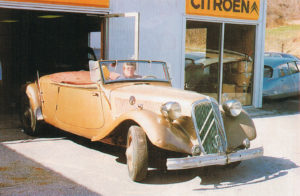 Brad Nauss driving the Madame Michelin 15-Six at Red Dellinger’s Garage
Brad Nauss driving the Madame Michelin 15-Six at Red Dellinger’s Garage
Dellinger told Citroënvie editor George Dyke that he bought the 15-Six Cabriolet from Augie Pabst, of the Pabst Brewing Company fame. Red elaborated that Pabst won the car in a poker game (probably in Chicago) because the owner had it stored in a Pabst’s garage and couldn’t even afford to pay the rent. He tossed Pabst the keys and that’s how he became he owner. Dyke is not sure if that person was Richard Haynes or not. Red told him that the Michelin car was owned previous to the poker incident by a Citroën dealer and Dyke thinks he mentioned that fellow was in the Chicago area.
Red Dillinger also told Dyke that the Mme Michelin car was found in a junkyard in France (outside Paris) and exported to the US where it was fixed up and repainted (yet again – according to Dellinger there were multiple layers of paint!). If the car was exported by the Citroën dealer or a previous owner is uncertain, according to this version of the history of the car.
Even if there are different versions of the history of this car too, it is definitely the genuine article, clearly identified by correct chassis and production numbers. It is so far the only known 15-Six Cabriolet that has been properly identified as a car produced in the Citroën factory.
In the Citroënvie interview, Dellinger also mentioned the car that inspired this article, and said “The only one I knew of was one that they put together after the war and it was touted as being the original 15/6. They assembled it out of pieces /from/ the various chassis and frames that were left.”
Dillinger sold his car to Nico Michon, a well known Citroën collector and restorer in the Netherlands in 1998. Michon restored the car to its original color and specifications before showing it at Retromobile in Paris in 2003. He eventually sold the car to another European Citroën collector.
Below are pictures of “Madame Michelin” from Rétromobile 2003, with Nico Michon showing the restoration he had just finished.
Another shady car
Everyone seems to agree that the car made for Madame Michelin is the only existing 15-Six convertible that was finished before WWII, but Olivier de Serres seems to believe that not only is the recently auctioned car a genuine 15-Six convertible assembled in 1946, but that there is another “real” 15-6 convertible built in 1946 around. Both of these cars he believes were assembled at the Citroën factory in 1946 from parts stored throughout the war. This second 1946 convertible is a car that allegedly was given the production number El 0131, a number that de Serres claims was found in “les mains courantes de Citroën”.
However, the factory ledgers do not lend clear support the claims that this car is an authentic 15-Six convertible. The number EI 0131 can be found in the factory ledgers but it is not clearly indicated to be for a convertible.
A closer look at this car, which was exhibited at Retromobile in 2014, disclosed that the plate with the production number most likely had been taken from another car and modified to show the number EI 0131. It looked as if the EI 0131 was stamped on top of a different number. Thus this plate does not prove that the car really is EI 0131, and there is no solid proof that this production number even belongs to a convertible.
It is actually more likely that the car touted to be El 0131 is a 15-Six convertible fabricated in the 1940s or 50s from a 15 sedan and a 4-cylinder convertible.
The present owner of the car claims that it was first registered in 1951, to a M. Claude Martell. It is possible that it is the same car mentioned by M. Bloch, who owned the “Michelin convertible” in 1951. M. Bloch had parked in Avenue Montaigne, when another 15-Six convertible parked nearby. The driver, who was from Juvisy, said that he had just finished the assembly of his car, and that it had been bought from the government in a box. This concurs with what M. Martell told about the history of the car. According to M. Martell, the car had been impounded by the government, and that he bought it in parts from “Domaines” (a French government agency) in 1941. On the other hand – if the car with production number El 131 was a sedan that was registered as such in 1946-1951, it is quite possible that it was used to build a convertible that was registered to M. Martell in 1951. But on the third hand – if that was the case there would have been no need to modify the plate with the production number stamped into it.
Martell moved to the US in 1955, where the car was restored a first time in 1969. When M. Martell died at the age of 84, the car was sold in a dismantled state to his mechanic. There was little interest in the car in the US, and in 2004 it was sold to a French company, Tracbar. The car was eventually sold to M. Gilles Bercet, who organized a much needed serious restoration.
Here are pictures of the alleged El 0131, taken at Retromobile 2013.
The only indication of authenticity of this car is the story told by M. Martell and the somewhat shady reference to the body number. There is no chassis number on the car, which de Serres explains with it being assembled in the Citroën Bureau d’Études. This would also be the explanation for the absence of chassis numbers in other 15-Six convertibles. But even if they had been assembled in the Bureau d’Études it would be very strange if they had been sold to private parties without regular chassis numbers!
There are also rumors that there were more convertibles stored in the basement, that the Germans impounded one of these cars and drove it to the south of France, where they abandoned it. It is said that the car was partially dismantled and that it was saved by a Citroën dealer, and that it later was exported to the U.S., which again could be M. Martell’s car. But as there is no proof whatsoever of this and other more or less fancy stories about more 15-Six convertibles, there is no reason to believe that there is any truth in the rumors.
Three convertibles verified in the ledgers
There is genuine uncertainty about the number of 15-Six convertibles actually built by the factory.
There seems to be general agreement that three cars were finished in 1939 (body and chassis numbers listed here are taken from Olivier de Serres book Le Grand Livre de la Traction Avant ):
- EE 0016, chassis #680959, built May 20 1939, delivered to M. Michelin, the whereabouts of which has been known from its manufacture until today.
- One car delivered to the French Ambassador in the US. No trace has been found of this car.
- One car delivered to Countess de Portes. The countess was the mistress of the French Minister President Paul Reynaud. The book “La Traction de mon Père” claims that the couple was using the 15-Six convertible in an attempt to flee the German occupation forces, and that they had an accident in which the countess was killed and the car destroyed. Olivier de Serres claims that the car involved in the accident was a Renault and that the countess’ convertible has disappeared without a trace.
There also seems to be agreement on at least three bodies, maybe four, possibly with drivetrains, that were not finished before the war, and put in storage in the basement of the Citroën factory. (According to André Louis, a close associate to Pierre Boulanger, the CEO, four bodies were stored in the basement). This makes a total of seven cars finished or partly finished in 1939.
One of these cars is said to have been finished in 1946 and delivered to M. Robert Puiseux, manager of Michelin. It carried the body number El 0168 and was given chassis number 682487. (This information has not been verified). This car was in a serious collision with a truck only 18 months later, and is thought to have been scrapped. But as Olivier de Serres notes – cars were scarce and very valuable in post-war France. It is possible that the car was repaired, and even more possible that parts from this car were used to build “new” 15-Six convertibles.
Mysteries unsolved
Two of the stored 15-Six convertibles appear in a picture taken in the Citroën factory basement in 1955. It is said that at least one of these cars was used to build a presidential limousine for French president Coty. Two presidential limousines were built, one by Chapron, and the other by Franay. The designer of the Franay limousine, Philippe Charbonneau, remembered that the car was built on a curious structure. It was based on a Familiale platform, with a convertible front end and rear suspension from a 15-Six Hydraulique. It is possible that the Chapron limousine was built on the same kind of base, but there is no verification at all of that.
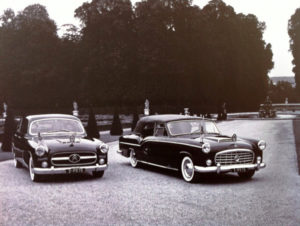 The two presidential 15-Six limos
The two presidential 15-Six limos
According to Buffetaut and Demetz the convertibles used for the presidential limousines carried the production numbers El 359 and El 368.
If this story about the presidential limousines is true, it explains the final fate of the two remaining convertibles proven to have been stored in the basement of the factory. But there are also rumors about a remaining convertible that was either scrapped or used to repair one of the presidential limousines.
Citroën historian Fabien Sabatés found a picture of a 15-Six convertible in storage. The car was apparently built before the war, even if it has a later grille, indicating that it might have the later D-engine. It is not known where and when the picture was taken, or if it is a genuine 15-Six convertible or one built by a coachbuilder. The picture adds to the mystery, but does nothing to clarify it.
To make things even more mysterious, it is said that another stored body was used to build a car in 1946 for a French industrialist, but so far no one seems to have found any proof of this in the Citroen ledgers. If it was built, it seems to have been built without being provided with chassis number. Why this would happen, when it seems that every other certifiable convertible got one, is difficult to explain.
Honest copies available
There are a lot more 15-Six convertibles around than the cars discussed here. Conversions of 15-Six Sedans to convertibles have been made by a number of coachbuilders and and restorers, from the early 1950s onwards. It is, in fact, still going on.
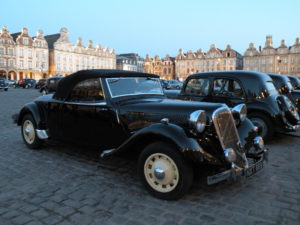
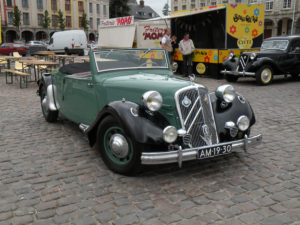
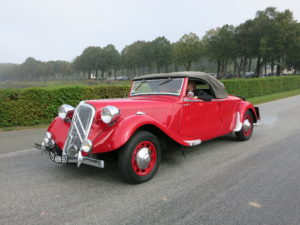
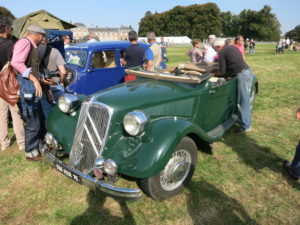

The French seem to believe that all pre-war 15-Sixes should have the chevrons behind the grille. According to Jens this only applies to the first series of 15-Sixes. Sales brochures for the 1939 15-Six show cars with the chevrons on the outside of the grille
If you want a Traction Avant 15-Six convertible to experience the exhilarating combination of open air and 15-Six driving, one of these conversions would be the right way to go. Most of them are of good quality and are sold with an honest declaration of their provenance.
I wish that the slaughter of good 15-Six Sedans would stop, but I suppose that is a feeble wish when there is so much money to be made from chopping off roofs. At least the 15-Six convertible builders of today only chop down 15-Six sedans. In the 1950s some of them welded the front end of a 15-Six sedan onto a pre-war convertible, destroying two rare cars in the process of making one 15-Six convertible clone.
Shady practice
The buyer of the red “1939” 15-Six Convertible must have been convinced that he bought an authentic, factory built 15-Six Convertible, an extremely rare, if not unique, original car. That is not what he got. Even if the body is authentic, which is uncertain, the engine and gearbox most likely are not. And the proof of authenticity provided by the auction firm was in no way conclusive. The seller probably would not have been able to get away with this at an American classic car auction. To sell a car as an original when there is no conclusive proof of origin and documentation showing that the later model engine truly was installed when the car was built would be seen as unacceptable.
Americans might sometimes go to far in their quest for “matching numbers”, but when the only numbers that add up are the dollars paid out by gullible people who think they are buying a truly unique vehicle, it is even worse.
However, owners of authentic but not so rare Traction Avants, should be happy that at least some TA models now are so appreciated by classic car investors that dubious practices from the world of art auctions are being applied to the marque. If nothing else, it should make the truly authentic Citroëns even more valuable.
It is not difficult to prove that you own an authentic, factory made Citroën. The Citroën Conservatoire is happy to provide you with a certificate of authenticity – provided that they can find your car in the production ledgers.
There is still hope!
And there is still hope for all who want to find an original factory built 15-Six convertible. The car delivered to the French ambassador to the US might still exist and hide in a dark corner of a Washington garage. The convertible delivered to Countess de Portes could be stored in an outhouse somewhere in the French countryside…
Thus, claims that a 15-Six convertible is genuine cannot easily be dismissed. It is definitely possible that the claims are true, as there are 15-Six convertibles listed in the Citroën ledgers, which are not accounted for. But when a car without a factory chassis number is presented as the real thing, there are strong reasons to be wary.
Note: The Citroën Conservatoire does not provide identifying information for individual cars to anyone but the owner of the vehicle, as this is crucial to the process of authenticating cars. The chassis and production numbers provided in this article are all quoted from Olivier de Serres book on the Traction Avant 15-Six and from the book “La Traction de mon Père” by Yves Buffetaut and Antoine Demetz. They have not been confirmed by the Citroën Conservatoire.
Citroën 15-Six Convertibles:
| 2 | 3 | 4 | 5 | 6 | 7 | 8 | 9 | |
| Production date | 1939 | 1946 | 1946 | 1946 | Stored at Javel | Stored at Javel | ||
| Production # | EE 016 | None | El 131 | El 168 | El 359 | El 368 | ||
| Factory VIN | 680959 | ? | ? | None | unknown | 682487 | unknown | unknown |
| Engine no | PD195 | PE568 | ||||||
| First owner | Mme Michelin, | Countess de la Porte | French Ambassador to the US | ? | Robert Puiseux | |||
| Where is it now? | Owned by French collector | ? | ? | Claimed to be a restored original (red) | Claimed to be a restored original car (yellow) | Crashed | Converted to presidential limo ? | Converted to presidential limo ? |
| Note | Verifiably authentic | Numbers match Citroen ledger | Numbers match Citroen ledger | Not verified in Citroen ledgers. ViN issued by French registration authority. | Not listed as convertible in ledgers | Not verified in Citroen ledgers | Not verified in Citroen ledgers | Not verified in Citroen ledgers |
The above table illustrates the difficulties in proving the authenticity of Citroen 15-Six convertibles.
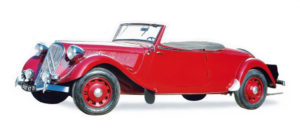
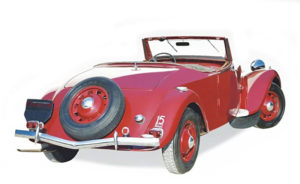

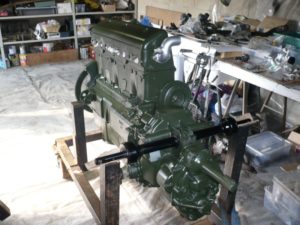
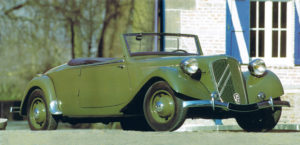
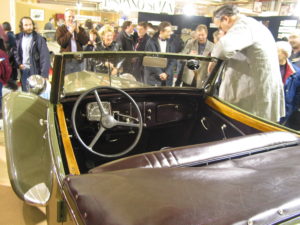


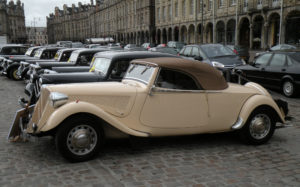

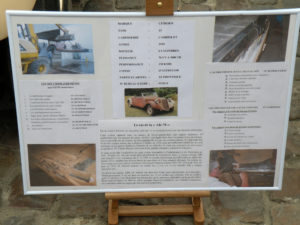
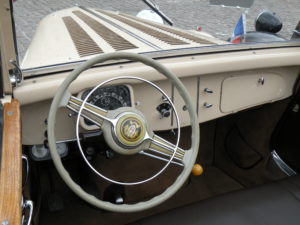
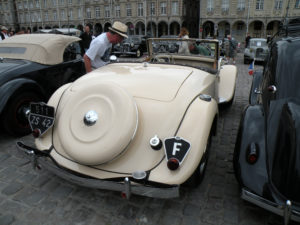
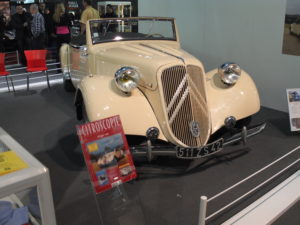

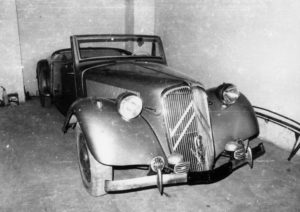

What an amazing article. My favorite topic! So cool it’s been researched so well… I’m now on the lookout for the 15-6 convertible missing in the States.
Now what about the 22CV cabriolet? If you want to find out you have to read my book FOUND, The Lives of Interesting Cars & How They Were Discovered. A Novel. Available on Amazon and at your local bookstore by ordering. Cheers!
Hallo! Je t’ai acheté les tomes 2 à 5 de “La vie de la Traction” Vendredi à Époqu’auto, après avoir vu un des tomes au stand de la TU. Bravo tout plein pour ta doc! J’ai hâte de découvrir les autres… Dank u Well nochmals. 🙂
Translate: Hallo! I bought you volumes 2 to 5 of “La vie de la Traction” Friday at Époqu’auto, after seeing one of the volumes at the TU stand. Well done for your doc! I can’t wait to discover the others… Dank u Well nochmals. 🙂
Comment: We think you are confusing Citroënvie with another book publisher, but we are happy you are enjoying your Traction books nonetheless.